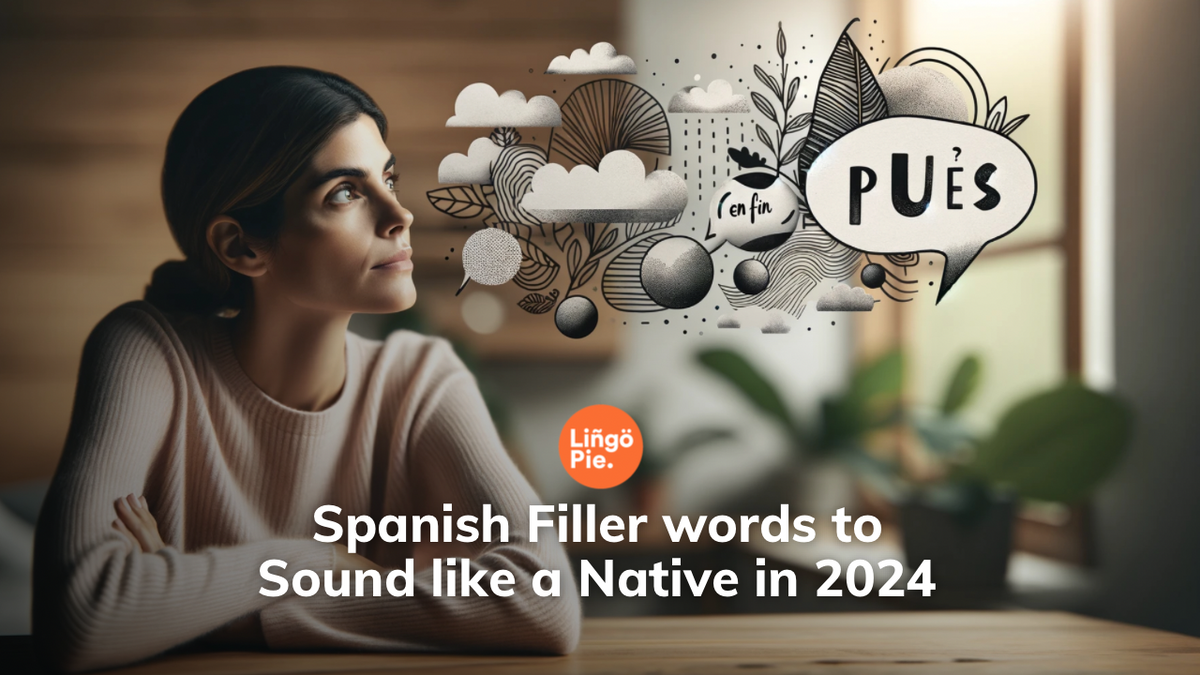If you're reading this, you're probably in need of some common Spanish filler words that will help you sound like a native Spanish speaker.
Filler words, known as "muletillas" in Spanish, are the unsung heroes of casual conversations. They add fluency, convey emotions, and enrich communication with cultural nuances.
Read on to discover fifteen essential Spanish filler words that native speakers tend to use in natural conversation daily. We'll explore why and how mastering these expressions is vital for embracing the natural flow of the conversational Spanish language.
Table of Contents
- 1. "Pues" - Adding a Casual Flair
- 2. "O sea" - Clarifying and Emphasizing
- 3. "En fin" - Wrapping Up Thoughts
- 4. "Es decir" - Expressing Clarification
- 5. "La cosa es" - Getting to the Point
- 6. "Y tal" - Adding a Casual Touch
- 7. "Pues sí" - Affirming with Confidence
- 8. "En serio" - Conveying Seriousness
- 9. "Pues nada" - Minimizing Importance
- 10. "Es como" - Drawing Comparisons
- 11. "En plan" - Describing Actions
- 12. "Literalmente" - Emphasizing Literal Meaning
- 13. "A ver" - Expressing Expectation or Transition
- 14. "Bueno" - Initiating Thoughts or Transitions
- FAQ
- Summing up
1. "Pues" - Adding a Casual Flair
"Pues" is a versatile filler word, seamlessly blending into sentences to convey a casual tone. Spanish speakers use it to soften transitions between thoughts and create a more relaxed atmosphere in conversations.
Mastering the use of "pues" allows you to navigate discussions with ease, making your speech sound more natural.
For example: "Vamos a la fiesta, pues, ya veremos qué pasa" (Let's go to the party, well, we'll see what happens).
2. "O sea" - Clarifying and Emphasizing
"O sea" is a powerful filler phrase used to clarify or emphasize a point. This is one of the common filler words you will hear a lot in Spain and Latin America.
Spanish speakers deploy it to ensure their message is clear and to underscore key information. Integrating "o sea" into your speech enhances your ability to articulate thoughts precisely and adds depth to your communication, expanding beyond just standard Spanish greetings.
For instance, "Estudiamos todos los días, o sea, nos esforzamos mucho" (We study every day, I mean, we put in a lot of effort).
3. "En fin" - Wrapping Up Thoughts
"En fin" serves as a subtle yet impactful phrase to conclude or summarize a discussion. Its usage signals the winding down of a topic, providing closure to a conversation.
This filler word adds a touch of finesse to your language skills, making your communication more polished and reflective of native speech.
For example, "Hicimos todo lo posible, en fin, no pudo ser" (We did everything we could, well, in the end, it didn't work out).
4. "Es decir" - Expressing Clarification
"Es decir" is a go-to phrase for expressing clarification or providing an explanation. Its usage allows you to elaborate on a point or offer additional context, ensuring that your message is fully understood.
Incorporating "es decir" into your speech repertoire enhances your ability to convey ideas with precision and depth.
An example of this word in context would be, "Vamos a salir temprano, es decir, antes de las seis" (We're going to leave early, I mean, before six).
5. "La cosa es que" - Getting to the Point
"La cosa es" serves as a direct and concise way to get to the heart of a matter. This filler phrase adds a touch of informality to your speech, allowing you to cut to the chase and focus on the essential point.
Embracing "la cosa es que" in your conversations enhances your ability to communicate efficiently, capturing the essence of native Spanish speech.
Let's take a look at this one in context too: "La cosa es que necesitamos hablar" (The thing is, we need to talk).
6. "Y tal" - Adding a Casual Touch
"Y tal" is a casual filler phrase used to add a relaxed and informal vibe to your speech. This expression is often employed in casual conversations to convey a sense of nonchalance or to suggest that there is more to the story.
Mastering the use of "y tal" allows you to infuse a natural and conversational tone into your Spanish speech.
For instance, "Fuimos a la playa, y tal, pero no hacía buen tiempo" (We went to the beach, and stuff, but the weather wasn't good).
7. "Pues sí" - Affirming with Confidence
"Pues sí" is a powerful affirmation filler phrase that adds confidence and conviction to your speech. This expression is commonly used to agree with a statement or confirm a fact.
Incorporating "pues sí" into your linguistic arsenal allows you to assertively agree while embracing the natural flow of native Spanish conversations.
For example, "¿Vas a la fiesta esta noche?" - "Pues sí, claro que sí" (Are you going to the party tonight? - "Well, yes, of course").
Read Also:



8. "En serio" - Conveying Seriousness
"En serio" is a versatile filler phrase that conveys sincerity, emphasizing the seriousness of a statement.
Whether expressing disbelief, surprise, or emphasizing the truthfulness of your words, incorporating "en serio" adds depth to your communication and helps you to sound more like a native Spanish speaker.
Mastering this expression enables you to navigate a spectrum of emotions, making your speech more nuanced and reflective of native Spanish conversations.
For instance, "¿Ganaste la lotería?" - "¡Sí, en serio!" (Did you win the lottery? - "Yes, seriously!").
9. "Pues nada" - Minimizing Importance
This is one of the filler words used to downplay the significance of a situation or to express a lack of importance.
Integrating this expression into your speech allows you to navigate conversations with a laid-back attitude, subtly shifting the focus away from trivial matters.
Embracing "pues nada" in your interactions adds a touch of nonchalance, contributing to the natural flow of native Spanish dialogue.
For example, "Intenté arreglar la impresora, pero pues nada, no funcionó" (I tried to fix the printer, but, well, it didn't work).
10. "Es como" - Drawing Comparisons
"Es como" is a filler phrase that facilitates the expression of comparisons or analogies in your speech.
Mastering the use of "es como" allows you to draw parallels between different situations, making your communication more vivid and relatable.
This expression enhances your ability to convey complex ideas by simplifying them through relatable comparisons.
For instance, "La película era es como un sueño, lleno de colores y emociones" (The movie was like a dream, full of colors and emotions).
11. "En plan" - Describing Actions
"En plan" is one of the most common filler words used to describe actions or events in a casual and laid-back manner.
This expression adds a touch of informality to your speech, allowing you to narrate experiences with ease.
Embracing "en plan" in your conversations enhances your storytelling skills, making your narrative more engaging and reflective of the natural flow of native Spanish speech.
For example, "Salimos anoche, en plan, a dar un paseo" (We went out last night, kind of, for a walk). Alright, this one doesn't translate so well in English, but think about how often we say 'like' as a filler word. It's, well, like that!
12. "Literalmente" - Emphasizing Literal Meaning
"Literalmente" is a filler word that adds emphasis to the literal meaning of a statement. In Spanish conversations, it is often used to clarify that a description or expression should be taken in its most straightforward sense.
Mastering the use of "literalmente" enhances your ability to convey precision in your language, ensuring that your message is understood exactly as intended.
For example, "Me comí literalmente toda la pizza" (I ate literally all the pizza).
13. "A ver" - Expressing Expectation or Transition
"A ver" is a versatile filler phrase expressing expectation or marking a transition in conversation. This phrase is usualy used to introduce actions or thoughts, it keeps the dialogue dynamic.
"A ver" adds anticipation and marks transitions, offering a fluid segue into new topics or actions. It keeps conversations dynamic, fostering engagement.
For example, "Vamos a probar ese nuevo restaurante, a ver qué tal." (Let's try that new restaurant, let's see how it is).
14. "Bueno" - Initiating Thoughts or Transitions
"Bueno" serves as a common filler word, initiating thoughts or transitions in spoken Spanish. It provides a natural lead-in to statements, creating a conversational rhythm.
"Bueno" seamlessly introduces thoughts or transitions in Spanish discourse, creating a conversational ebb and flow.
Whether pondering ideas or shifting topics, its use reflects a natural rhythm, as in, "Bueno, creo que es hora de irnos. ¿Qué opinas?" (Well, I think it's time to leave. What do you think?)
FAQs Regarding Common Filler Words
Understanding and mastering filler words is key to fluent communication. In this section, we provide answers to common questions relating to the importance of these phrases in Spanish conversation.
Is "technically" a filler word in Spanish?
In English, "technically" can function as a filler word, often used to add precision or emphasis. It is far lesson common in Spanish.
What are common Spanish filler words?
Common Spanish filler words include "pues," "o sea," "en fin," and "es decir." Native Spanish speakers use these expressions to add fluency, clarify points, and convey a more natural conversational tone.
Why avoid filler words?
In written Spanish, it is best to avoid filler words. However, they are great tools to help you sound like a native and while you gather your thoughts in Spanish. Using filler words in conversation creates a form of more authentic spoken Spanish.

Summing up: Common Spanish Filler Words
Incorporating Spanish filler words into your language repertoire goes beyond linguistic enrichment—it will make you sound more like a native Spanish speaker.
By mastering these filler words, you not only enhance your conversational skills but also immerse yourself in the rhythm of Spanish speech.
In addition to this, doing so helps you to avoid awkward silence sometimes. So, as you embark on this linguistic journey, remember that these filler words are more than linguistic tools—they are the heartbeat of genuine, culturally-rich communication in Spanish.
If you're ready to take the next step in your Spanish journey, sign up for a free trial with Lingopie today.










